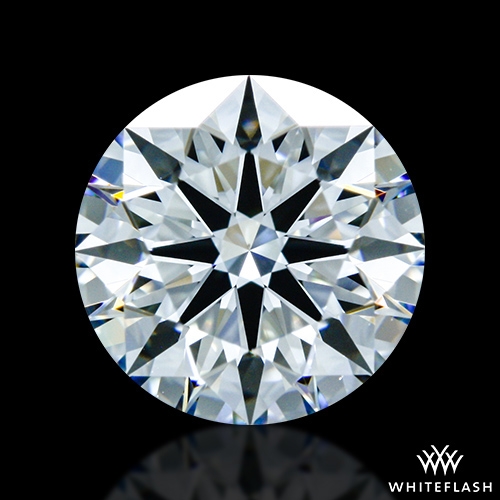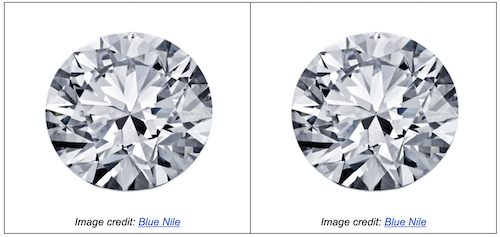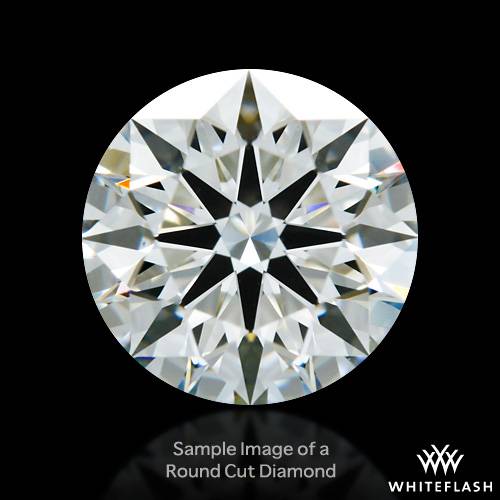This page contains references to diamonds or engagement rings from different companies. Sometimes I do receive a commission when you click on links and buy the products.
Diamond pricing is the biggest consideration for a potential buyer. Evidently, diamonds can be some of the most expensive items out there, and so buying them should always come with the care and attention you’d give to any other large investment. This means that, high on the agenda of everyone purchasing a diamond is being sure you’re getting great value for money.
Whichever end of the budget scale you’re at, or somewhere in the middle, it is important to know that the diamond you’re buying is worth its price tag. For many people, this is a daunting prospect. Unfortunately, there are many businesses ready to take advantage of any perceived naïveté. Go in armed with some knowledge of diamond pricing, and you’ll be sure to get best bang for your buck.
Understanding diamond pricing can make the difference between you buying something disappointing and something truly worthwhile. Image credit: Whiteflash
So where do you begin? Do you start by looking for the cheapest diamond? Do you start by looking for what sounds like a good deal? Unfortunately, when it comes to diamonds, it’s not that simple. Fortunately, the following guiding information will help you on your way to becoming a diamond pricing expert.
- Understanding Diamond Pricing
- What Determines the Price of a Diamond?
- Determining the Price of a Diamond – The Finer Detail
- Avoiding Bad Deals
- How to Safely Buy a Diamond
Understanding Diamond Pricing
There are a number of variables that affect the price of a diamond. Understanding each of these variables, and the effect it has on the overall price, will enable you to determine if the price you’re being charged is a reasonable one.
Overall, the crudest determiner of diamond price is the carat weight. It’s not an inaccurate statement, as more often than not, the bigger the diamond, the bigger the price tag. Using this simplest variable you can understand the price of a diamond as:
Cost of diamond = the carat weight x price per carat.Take these two diamonds, both from the trusted and popular diamond seller Blue Nile (whom you can see our review for here). As you can see, in terms of their respective qualities, they’re quite similar.
The first diamond is a VS1 clarity diamond, with F color, and an Ideal cut. The second diamond has these exact characteristics also, but is around $1,300 less expensive. Why the big difference in price? Because the first diamond is 0.19 carats larger.
However, while looking at carat weight is a semi-useful measurement when first viewing diamonds, it shouldn’t be relied upon. In honesty, only looking at carat weight is too crude a way of determining the price of a diamond. This method really is only good for providing a broad, ballpark figure, and determining true diamond pricing is a lot more complex than this.
What Determines the Price of a Diamond?
If you’ve done much looking about on Your Diamond Guru, then you will often see references to the 4Cs of diamonds. Understanding the 4Cs is important for understanding diamond pricing.
The 4Cs stand for:
We’ve examined carat weight briefly above, but let’s look at the pricing of diamonds in more detail by taking into account all of the 4Cs. The 4Cs combined come together to determine the quality of the diamond, and thus are a more accurate grounding for determining price than carat weight alone.
So how do these qualities affect diamond pricing?
Color
Diamonds come in a variety of colors, and this affects the price. We’re not just talking about Fancy Colored diamonds here (which are favored because they a color), so much as the degree of slight yellowness that diamonds have.
Diamond color is ranked on a scale from D (no color) to Z (noticeably yellow). Generally speaking D-F are deemed colorless and G to J as near colorless. The highest prices are commanded by those which are closest to D, or naturally intense colors such as blue, yellow, pink or red. This is further important due to the color hue, or tint. Different hues are more desirable than others. Yellowish is preferred over brown or grey for example.
Compare these two diamonds from James Allen, a diamond retailer with one of the largest collections of diamonds available.
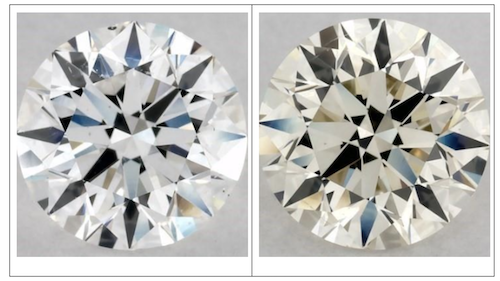
Image credit: James Allen and Image credit: James Allen
Both these diamonds have an SI1 clarity grade and are both 1 ctw (in fact, the diamond on the right is 0.01 ctw larger). They are also both of Excellent cut. As you’ve probably guessed, the diamond on the left is more expensive, as the diamond on the right has a very noticeable yellow hue to its color. That color difference (amongst other key attributes) has given rise to a price difference of more than $3,000.
Clarity
Clarity refers to the number of imperfections, or ‘inclusions’, within the diamond, and the blemishes that sit on the outside of the diamond. These are scratches, trace elements, and other factors which affect the light return or integrity of the diamond. The vast majority of diamonds aren’t truly ‘flawless’, and there are degrees in clarity that are ranked on a scale.
Clarity is ranked using the following grades:
- FL (Flawless) – No inclusions or visible blemishes under 10× magnification.
- IF (Internally Flawless) – No inclusions, however there may be small amounts of surface graining (barely visible under 10x magnification.)
- VVS1 (Very, Very Slightly Included 1) – Inclusions are extremely hard to see using 10× magnification.
- VVS2 (Very, Very Slightly Included 2) – Inclusions are difficult to see using 10× magnification.
- VS1 (Very Slightly Included 1) – Inclusions are tricky to see using 10× magnification.
- VS2 (Very Slightly Included 2) – Inclusions will not affect the beauty of a diamond and are only detected using 10× magnification.
- SI1 (Slightly Included 1) – Inclusions are noticeable using 10× magnification and some will be visible to the naked eye.
- SI2 (Slightly Included 2) – Inclusions are noticeable using 10× magnification and the most will be visible to the naked eye.
- I1, I2, and I3 (Included) – Inclusions are very obvious using 10× magnification and to the naked eye.
As you can tell, the higher the clarity grade, the higher the price.
Cut
The role of the diamond cutter is a skilled combination of both art and science. How the diamond is cut determines how much of the original rough carat weight is maintained, but also the overall look of the diamond. This is a fine line to walk. As a result, the cut is probably the most complex determiner of price.
The aim of a cut is to maximize light return. This requires symmetrical facets and good proportions, along with expert finishing.
Carat Weight
As explained, the carat refers to the weight of the diamond. Prices for diamonds are priced ‘per carat’. However, it’s not quite that simple. As carat weight increases, diamonds are put into different categories. The price per carat increases exponentially as you move up through the categories. This is based on supply and demand. There are many more diamonds available in the lower categories than in the higher ones. It’s also because diamond purchases are often emotional decisions, and this affects the perception of the higher category carat weights.
Determining the Price of a Diamond – The Finer Detail
Determining the price of a diamond is not down to the 4Cs alone. In fact, it’s possible to find diamonds with identical 4C ratings, which are still priced differently.
So why is this? The following factors also affect how a diamond is priced.
- Fluorescence: This is the tendency of the diamond, under ultra-violet light, to emit a soft blue glow. It is perceived as a defect, and therefore lowers the price of colorless (D-F) diamonds. However, for near-colorless (G-J) it can actually slightly increase the price.
- Eye-clean: As well as clarity, it’s important to note that sometimes inclusions are visible to the naked eye, and sometimes not. Obviously those which can be seen without specialist equipment will have a lower price. Additionally, the type of inclusions affect price.
- Polish and symmetry: The rating of the polish and symmetry will also affect the price.
- Precision of cut: The cut alone is a factor affecting price, but so is its precision. A hearts and arrows cut, for example, requires absolutely extreme precision requiring the most expert diamond cutter.
- Girdle Thickness: The girdle is the narrow perimeter dividing the crown and the pavilion. When looking side-on, the girdle is the widest area, important because it is where the stone is in contact with the setting. It affects durability.
Let’s compare two diamonds from Whiteflash. The first diamond is a 0.70 ct F VVS2 Round Cut Loose Diamond and the second is also a 0.70 ct F VVS2 Round Cut Loose Diamond, but there is $100 between their prices.
First of all, the more expensive diamond has a wider girdle, leading to a potentially better light return and durability. The other, however, isn’t as wide. Curiously, the first diamond has a faint fluorescence and the second does not, meaning it is most likely the width of the first that has affected its price. That being said, the difference in price is not huge, and you will most likely find diamonds with the same Four C characteristics priced fairly similarly.
If you’re considering Whiteflash, make sure you look at their A Cut Above Diamonds:
Avoiding Bad Deals
Jewelers want to get the best return on each diamond they sell. As with all businesses, you get scrupulous jewelers, and others who will do anything they can to achieve the highest sale. One noticeable way that this happens is by showing you a ‘Rapaport Report’ and pointing out the price list.
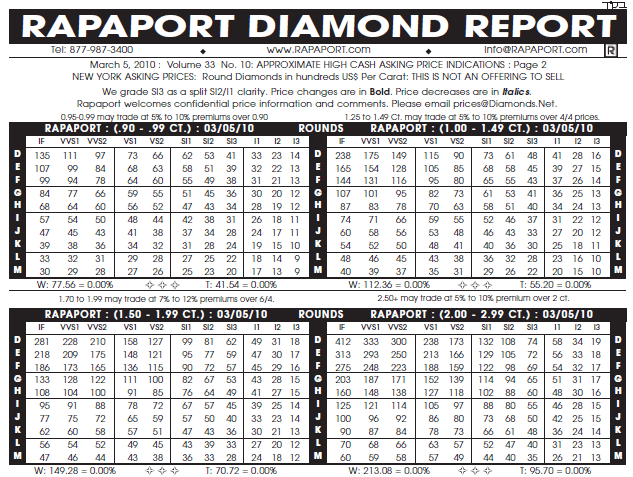
There isn’t always significant change each week. It’s used for individually-sold diamond pricing, not packages. It covers diamonds of a certain quality (usually SI3 or above in clarity, and K or above in color). The report is a matrix aligning color against clarity within different size categories. Interpreting the Rapaport as an individual consumer is complicated, and hence I recommend other techniques.
What the Report shows you the highest cash value of a diamond, and so you can think you’re getting a ‘good deal’. This isn’t the reality. Understanding the report takes an expert eye. Your jeweler should be able to explain the pricing of a particular diamond in much more detail than resorting to this tactic.
There is also the overwhelming fact that the ‘Rap List’ is rather crude itself. It doesn’t look at the cut of the diamond, the certification, or retailer-specific factors such as payment terms, accuracy of grading, fluorescence, and more.
You should always search for a diamond retailer who is willing to explain, in detail, the reason that a diamond has been priced as such.
How to Safely Buy a Diamond
If you are unsure about the pricing of a diamond, a way to establish peace of mind is to compare similar diamonds from different jewelers. If you choose jewelers who are known for their fair business ethics, and industry reputation, such as Whiteflash, Brilliant Earth, James Allen, or Blue Nile, then you can be sure you are making a sensible choice and a good comparison.
Furthermore, always request certification, especially if you are spending over $1000 on the proposed diamond. This backs up any claim that the jeweler is making, and provides you with written evidence. I would recommend only purchasing a diamond with an AGS or GIA certificate, for more information take a look at my piece on Diamond Certification here.
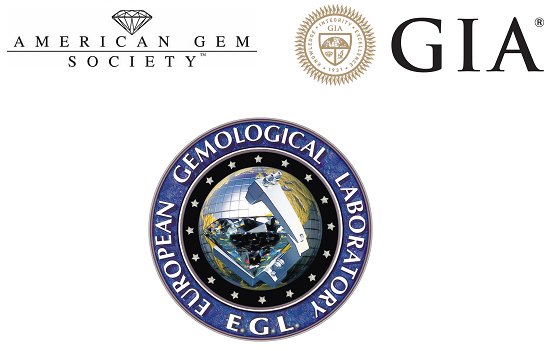 While it’s unlikely that you’ll be able to avoid the Rapaport list altogether, there are other aids to help you when determining a fair diamond price. One of the problems with Rapaport is its difficulty to understand, even as a professional. This is because the methodology behind it is somewhat cloak and dagger. The IDEX Diamond Price Report, however, is completely upfront about its methodology. It’s used for B2B diamond exchanges, so isn’t wholly useful for a consumer, but it can help, especially when taken in conjunction with the Diamond Retail Benchmark. Nonetheless, it can be confusing for a consumer.
While it’s unlikely that you’ll be able to avoid the Rapaport list altogether, there are other aids to help you when determining a fair diamond price. One of the problems with Rapaport is its difficulty to understand, even as a professional. This is because the methodology behind it is somewhat cloak and dagger. The IDEX Diamond Price Report, however, is completely upfront about its methodology. It’s used for B2B diamond exchanges, so isn’t wholly useful for a consumer, but it can help, especially when taken in conjunction with the Diamond Retail Benchmark. Nonetheless, it can be confusing for a consumer.
Your single biggest reassurance will come from choosing a reputable retailer who will be prepared to take the time to guide you through the pricing of a particular diamond.
There is no single determiner of a diamond’s price. It is a complex interaction of different variables. Understanding it requires a level of knowledge that you simply don’t need for any other purchase. While diamonds are of course one of life’s significant purchases, and therefore you expect to do more research, it can be daunting. You can be worried that you aren’t getting a fair deal, or that the diamond won’t hold its value. This is why choosing a reputable jeweler is the most important step when understanding the pricing of a diamond.
If you have any doubts about a diamond, engagement ring or dealer then please get in touch with me directly for free independent advice.
Our Diamond Retailer Recommendations
Here at Your Diamond Guru, we’re always on the lookout for top-notch diamonds and top-notch retailers and jewelers. The four that consistently stand out to us are Whiteflash, James Allen, Brilliant Earth or Blue Nile. You can read our reviews of them by clicking on their links. If you’re curious about more of our reviews, head to our review section here.

Richard Jenkins, The Diamond Guru
Get free assistance from the Diamond Guru today. You’ll be glad you did!
- Secure the best quality diamond for your budget.
- Don’t pay over the odds for your diamond ring.
- Have piece of mind that you didn’t get ripped off.
Have a Question? Contact us now…


